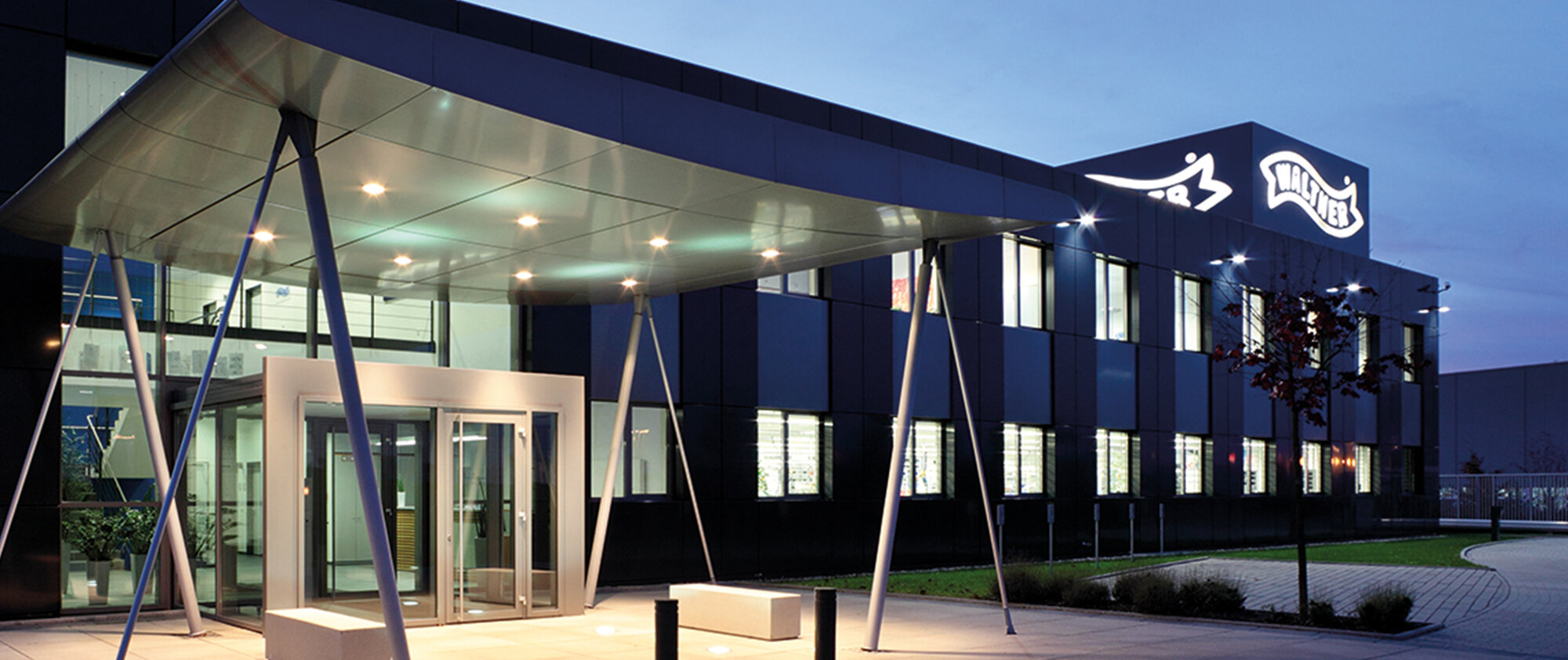
THE FIRST CENTURY
Walther: 130 years of innovation in gun manufacturing
For centuries, areas with ore deposits have been centers of firearms manufacturing. An important example is the region around Suhl and Zella-Mehlis in Thuringia. Modest blacksmiths gave rise to special trades such as that of rifle maker, which was the trade of the forefathers of the Walther family. One of them was August Theodor Walther, who married the granddaughter of the respected rifle maker Gustav Wilhelm Pistor, from Asbach-Schmalkalden. Their son, Carl Wilhelm Freund Walther, laid the foundation for the Walther company. Born in 1858, he started his own rifle making business in 1886. With the assistance of his apprentice, Carl Walther began to manufacture hunting and target shooting rifles with Martini and Aydt breech block actions. At that time, the 28-year-old had very little equipment and few tools at his disposal.
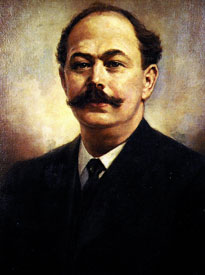 Carl Wilhelm Freund Walther (1858 - 1915)
Carl Wilhelm Freund Walther (1858 - 1915)
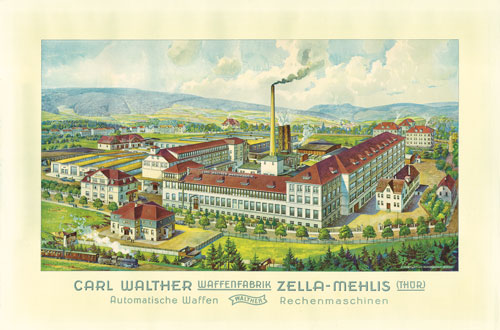 The impressive Walther plant in Zella-Mehlis, already with the addition "computing machines" (around 1935)
The impressive Walther plant in Zella-Mehlis, already with the addition "computing machines" (around 1935)
Carl Walther’s wife also came from a rifle manufacturing family. They had five sons: Fritz, Georg, Wilhelm, Erich, and Lothar. The first three learned the profession of rifle making at their parents’ company, Erich pursued a career in business, and Lothar trained as a tool and die maker. The work progressed, and in 1903 a small factory was built on the Katzenbuckel hill in Zella-Mehlis.
Fritz Walther was particularly interested in the burgeoning semi-automatic pistol technology, which he had learned about during his training in Berlin, at the time a center of handgun manufacturing. Through his many letters he convinced his father Carl that the future of firearms manufacturing would be in this sector. In 1908, after Fritz had returned home, the two of them proudly presented the prototype of their Model 1, which received a patent in June 1911 and went into production in a 6.35 mm version.
Other pistols followed, until the series ended in 1920 with the Model 9. In the fall of 1921, a much-talked-about self-loading shotgun was introduced to the market, and in 1932 the company designed double-barrel shotguns, which were followed by small-bore rifles. After his father’s death in 1915, Fritz Walther took over the company, with his brothers by his side.
Their range of products expanded to include calculators. During the 1920s, these small miracles of addition, with their typical WALTHER banners, were found on most desks around the globe. Fritz Walther, meanwhile, concentrated on his worldwide success in the firearms sector. He even motivated his own employees to show their initiative in the designs. Engineer Walter Riem, for example, developed a gas and alarm pistol called Perfecta in 1937. This laid the foundation decades later for the Umarex company (which we will come back to).
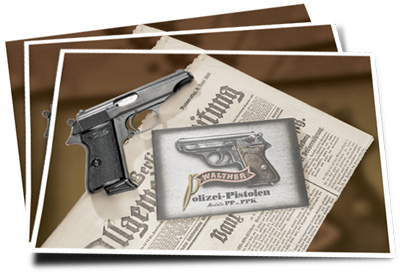 The double-action pistol Walther PP was introduced 1929, the shorter PPK 1931
The double-action pistol Walther PP was introduced 1929, the shorter PPK 1931
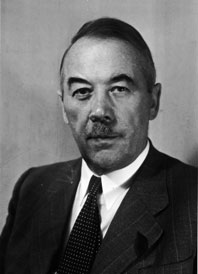 Fritz Walther (1889 - 1966)
Fritz Walther (1889 - 1966)
Even though double-action revolvers had thus far been unable to penetrate the market, Fritz Walther recognized the potential of this technology. In 1929, he implemented it in his latest model. The PP was born – and was a spontaneous success all over the world. A compact design, PPK, followed two years later. Both models proved perfect from the very beginning, and are still produced today. The public authorities in particular were very much interested in the PP and PPK, but the pistols were also in high demand in civilian circles.
All that remained was the military sector, which Walther supplied with the legendary P38 model. This pistol also exceeded all expectations and became by and by the successor of the Luger 08, the former ordnance sidearm. But Walther wasn’t able to supply the large quantities that the German armed forces requested. So the Ordnance Department (“Waffenamt”) decided that the P38 also had to be produced by Mauser in Oberndorf and by the Spreewerke in Berlin-Spandau. By the end of the war Walther had supplied around one half (580,000) of the 1.2 million guns produced up to that time.
A thin folder with design drawings and the rights to more than 80 patents were all that Fritz Walther was able to save from the turmoil of the war. He started over near Ulm. History repeated itself as Fritz Walther, like his father before him, was left with nothing. A small shoe repair shop was the nucleus and thus the Walther company was born anew. Soon, production sites for office machines were added in Niederstotzingen and Gerstetten. As early as April 1949, the employees celebrated the production of the 1,000th calculating machine. For Fritz Walther the revenues meant that he was once again able to devote his time to his profession. Weapons production began again at the Donaubastion in Ulm. By late 1950, the first 100 air guns were ready for shipment. Fritz Walther had done it!
The next step led to a new edition of the still sought-after PP/PPK and P38 pistols. The latter, under the name P1, became the sidearm for the new German armed forces. Other pistols were designed: the TP, TPH, PP-Super, P5, and finally the P88. There was also a breakthrough among long guns, in the form of hunting and sporting rifles of all kinds. Production of small-caliber match rifles, for example the legendary KKS and KKM series, began as early as 1953. In December 1966, Fritz Walther died and his son Karl-Heinz took the reins.
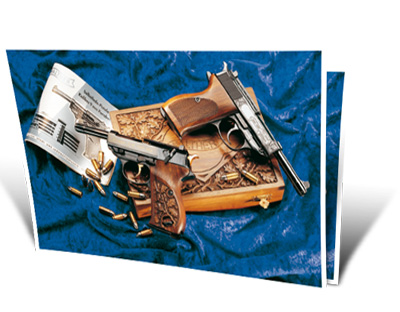 Walther limited, engraved editions of the P38: in front 50 years 1938-1988, in the back "100 Years Carl walther 1886 - 1986"
Walther limited, engraved editions of the P38: in front 50 years 1938-1988, in the back "100 Years Carl walther 1886 - 1986"
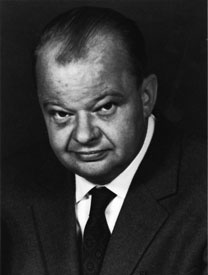 Karl-Heinz Walther (1923 - 1983)
Karl-Heinz Walther (1923 - 1983)
The new director expanded the company’s line of sporting guns and moved its main production facilities to Ulm. In 1969 the Walther GSP was launched. This small-caliber sport pistol continued the success of the similarly designed rapid-fire OSP, which had been on the market since 1961. The GSP was probably the most widely used small-caliber match pistol in the world, and it retained this status past the turn of the century. The KK-Match rifle made a name for itself especially in Olympic competitions. In Montreal (1976) Lanny Bassham used it to win a gold medal for the United States in the prestigious three-position competition (3 x 40 shots), and Malcolm Cooper won gold for the United Kingdom in two consecutive Olympics (1984 in Los Angeles and 1988 in Seoul). On November 2, 1983, Karl-Heinz Walther died unexpectedly, leaving the company in the hands of his nephew Hans Fahr, the last representative of the family.